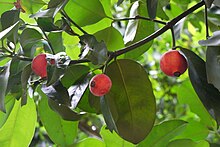
Mangosteen, also known as the purple mangosteen, is a tropical evergreen tree with edible fruit native to island nations of Southeast Asia and Thailand. Its origin is uncertain due to widespread prehistoric cultivation. It grows mainly in Southeast Asia, southwest India and other tropical areas such as Colombia, Puerto Rico and Florida, where the tree has been introduced. The tree grows from 6 to 25 metres tall. The fruit of the mangosteen is sweet and tangy, juicy, somewhat fibrous, with fluid-filled vesicles, with an inedible, deep reddish-purple colored rind (exocarp) when ripe. In each fruit, the fragrant edible flesh that surrounds each seed is botanically endocarp, i.e., the inner layer of the ovary. Seeds are almond-shaped and -sized.

Garcinia is a genus of flowering plants in the family Clusiaceae native to Asia, America, Australia, tropical and southern Africa, and Polynesia. The number of species is disputed; the Kew Gardens recognise up to 400. Commonly, the plants in this genus are called saptrees, mangosteens, garcinias, or monkey fruit.

Beruas is a small town in Manjung District, Perak, Malaysia.

Garcinia madruno, the charichuela, is a fruit-producing tree species from the rainforests of Central and South America. The leaves are dark green and leathery. The fruit looks like a shriveled droopy lemon, and has a similar rind. The interior is soft white pulp and has a popular, slightly citrusy taste people have compared to a sweet santol fruit or lemony cotton candy. The species was formerly included in the genus Rheedia, which has since been absorbed into Garcinia, as Rheedias species are now known as "new world mangosteens".

Garcinia prainiana, known as the button mangosteen or cherapu is a species of Garcinia. It has a flavor similar to, but distinct from, its cousin, the purple mangosteen, with an interesting taste some have compared to a tangerine, but unlike its cousin, it has a tissue-thin skin rather than a hard rind, making it much easier to eat out-of-hand. Also unlike the purple mangosteen, it can be grown in a container. The fruit is cultivated in Southeast Asia, by a few backyard growers in South Florida, and at the Whitman Tropical Fruit Pavilion at Florida's Fairchild Tropical Botanic Garden.

Mangostin is a natural xanthonoid, a type of organic compound isolated from various parts of the mangosteen tree. It is a yellow crystalline solid with a xanthone core structure. Mangostin and a variety of other xanthonoids from mangosteen have been investigated for biological properties including antioxidant, anti-bacterial, anti-inflammatory, and anticancer activities.

Garcinia intermedia is a species of tropical American tree which produces tasty fruit. In English it is known as the lemon drop mangosteen. In Spanish it is called mameyito, though it is known as jorco in Costa Rica. In the Philippines, it is known as berba. In Portuguese it is called achachairu. The name achachairu is also applied to Garcinia humilis, another species native to Bolivia with larger, round or egg-shaped fruit. G. humilis has been commercialized in Australia under the name Achacha.
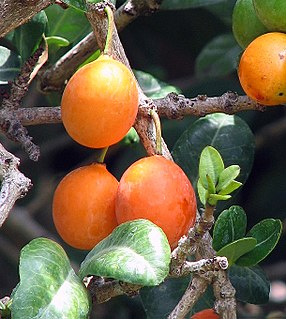
Garcinia livingstonei is a species of Garcinia, native to a broad area of tropical Africa, from Côte d'Ivoire east to Somalia, and south to South Africa.

Garcinia kola (bitter kola is a species of flowering plant belonging to the Mangosteen genus Garcinia of the family Clusiaceae. It is found in Benin, Cameroon, Democratic Republic of the Congo, Ivory Coast, Mali, Gabon, Ghana, Liberia, Nigeria, Senegal and Sierra Leone. Its natural habitat is subtropical or tropical moist lowland forests.

Garcinia gardneriana, the bacupari, is an evergreen, dioecious species of the genus Garcinia. It is distributed throughout South America's Amazon Basin and produces fruit with edible arils. In Brazil there is currently research to use this fruit to combat cancer.
The vernacular name lemon drop mangosteen is applied to two species of tropical American fruit trees.
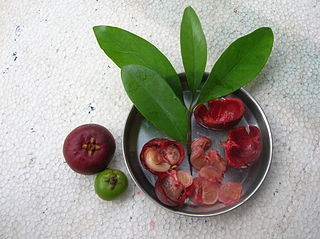
Garcinia indica, a plant in the mangosteen family (Clusiaceae), commonly known as kokum, is a fruit-bearing tree that has culinary, pharmaceutical, and industrial uses.

Garcinia pedunculata, popularly known as Bor Thekera in Assamese, is an evergreen tree related to the more familiar purple mangosteen. The tree is endemic to the south-eastern regions of Asia such as parts of Myanmar and north-eastern parts of India.
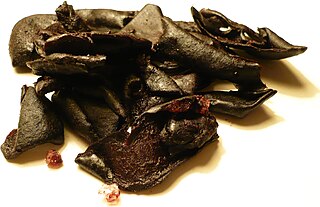
Kokum oil is a seed oil derived from the seeds of the kokum tree. Kokum oil is edible and can also be used for things other than cooking.

Garcinia warrenii, a is a fruit-bearing tree, up to 15 metres in height, of the mangosteen family (Clusiaceae), commonly known as native mangosteen or Warren's mangosteen. It is found in the tropical rainforests of northern and north-eastern Australia and New Guinea. The genus Garcinia, belonging to the family Clusiaceae, includes about 200 species found in the Old World tropics, mostly in Asia and Africa. Garcinia warrenii is indigenous to New Guinea, the Torres Strait Islands, northeastern Queensland from Cape York Peninsula south to Babinda, and a small, isolated population on Melville Island in the Northern Territory, Australia.
Garcinia binucao is a species of flowering plant in the Clusiaceae family. It is commonly known as binukaw or batuan, is a species of Garcinia native to the Philippines and Vietnam. It is not cultivated, though its edible fruits are harvested from the wild for use as a souring agent in some Filipino dishes.
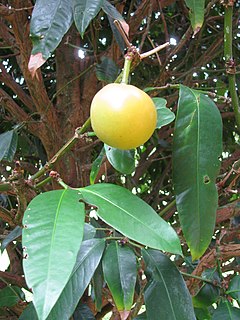
Garcinia xanthochymus, the false mangosteen, gamboge, yellow mangosteen, Himalayan Garcinia, or Sour Mangosteen is a species of mangosteens found from India, southern China, and Japan through Indochina to Peninsular Malaysia at elevations of 0 - 1400 meters. Plants are found growing in humid forests of valleys or on hills. It's locally known as Defol (ডেফল) in Bengal; Tepor Tenga in Assam; and Heirangoi (হৈরাংগোই) in Manipur.
Garcinia cowa, commonly known as cowa fruit or cowa mangosteen is an evergreen plant with edible fruit native to Asia, India, Bangladesh, Myanmar, Malaysia, Vietnam, Laos, Cambodia, Southwest China. The tree is harvested from the wild for its edible fruits and leaves, which are used locally. Flowers are yellow, male & female flowers are separated.
Garcinia assamica, is a newly discovered species of plant found in areas near Manas National Park, Assam. It seems to be rare and is hitherto only known from very few individuals, near to a rivulet. This new species is allied to Garcinia nigrolineata in arrangement of flowers on axillary short spikes; arrangement of stamens on a convexdisc and number and arrangement of staminodes in female flowers; but it is distinct from the latter in having greenish-yellow exudate; 2–5 female flowers fascicled at nodes against solitary flowers; 4–5-locular ovaries against 5–7-locular ones.
